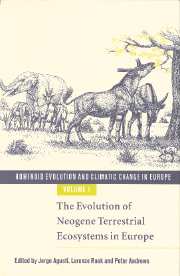Book contents
- Frontmatter
- Contents
- List of contributors
- Acknowledgements: The European Science Foundation
- 1 Introduction
- PART I Palaeogeography of the circum-Mediterranean region
- PART II Miocene mammalian successions
- PART III Palaeoenvironments: non-mammalian evidence
- 14 Marine invertebrate (chiefly foraminiferal) evidence for the palaeogeography of the Oligocene–Miocene of western Eurasia, and consequences for terrestrial vertebrate migration
- 15 Palaeoclimatic implications of the energy hypothesis from Neogene corals of the Mediterranean region
- 16 Contribution to the knowledge of Neogene climatic changes in western and central Europe by means of non-marine molluscs
- 17 Sedimentary facies analysis in palaeoclimatic reconstructions. Examples from the Upper Miocene–Pliocene successions of south-central Tuscany (Italy)
- 18 Neogene vegetation changes in West European and West circum-Mediterranean areas
- PART IV Palaeoenvironments: mammalian evidence
- Index
15 - Palaeoclimatic implications of the energy hypothesis from Neogene corals of the Mediterranean region
from PART III - Palaeoenvironments: non-mammalian evidence
Published online by Cambridge University Press: 15 December 2009
- Frontmatter
- Contents
- List of contributors
- Acknowledgements: The European Science Foundation
- 1 Introduction
- PART I Palaeogeography of the circum-Mediterranean region
- PART II Miocene mammalian successions
- PART III Palaeoenvironments: non-mammalian evidence
- 14 Marine invertebrate (chiefly foraminiferal) evidence for the palaeogeography of the Oligocene–Miocene of western Eurasia, and consequences for terrestrial vertebrate migration
- 15 Palaeoclimatic implications of the energy hypothesis from Neogene corals of the Mediterranean region
- 16 Contribution to the knowledge of Neogene climatic changes in western and central Europe by means of non-marine molluscs
- 17 Sedimentary facies analysis in palaeoclimatic reconstructions. Examples from the Upper Miocene–Pliocene successions of south-central Tuscany (Italy)
- 18 Neogene vegetation changes in West European and West circum-Mediterranean areas
- PART IV Palaeoenvironments: mammalian evidence
- Index
Summary
Introduction
Fossil corals have long been used for palaeoenvironmental interpretation, largely because many extant taxa are restricted to warm shallow tropical marine waters, and this is commonly extrapolated to the fossil coral record on simple uniformitarian grounds. For the most part, this approach has been largely qualitative, the presence of corals, or more particularly, the presence of ‘reef corals’, at a particular place being used to infer a warm climate, and their absence to infer a cool climate. By extension from this, the northernmost and southernmost limits of reef coral distributions in the past have also been used to infer times of global warming and cooling (e.g. Adams et al., 1990), since the global reef coral belt has varied in width through time. The present paper is a preliminary attempt to make more use of the potential of corals, by invoking the ‘energy hypothesis’, which provides a quantitative relationship between taxonomic richness and prevailing temperatures. This is used here to derive actual palaeotemperatures from the Miocene coral record of the Mediterranean region.
Palaeontological and taxonomic background
The corals which are the subject of this contribution belong to the order Scleractinia which first appeared in the Middle Triassic (Roniewicz & Morycowa, 1993). Scleractinia are also common in modern seas, where they are a major biotic element of coral reef habitats like the Great Barrier Reef, as well as forming deep and cool water coral banks (Stanley & Cairns, 1988).
- Type
- Chapter
- Information
- Hominoid Evolution and Climatic Change in Europe , pp. 309 - 327Publisher: Cambridge University PressPrint publication year: 1999
- 5
- Cited by

